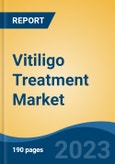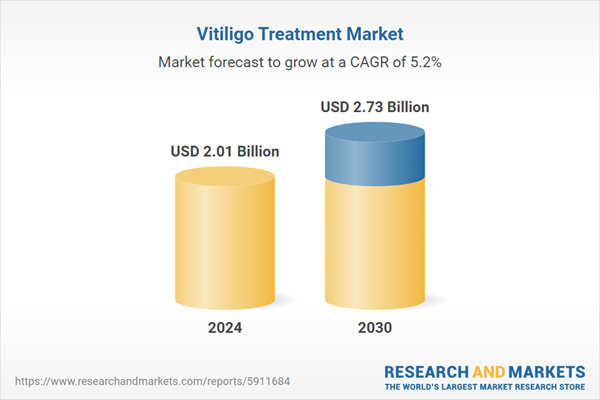Free Webex Call
The Vitiligo Treatment Market was valued at USD 2.01 Billion in 2024, and is expected to reach USD 2.73 Billion by 2030, rising at a CAGR of 5.22%. The Global Vitiligo Treatment Market is experiencing significant growth, driven by an increasing focus on early diagnosis and personalized treatment options. The rising awareness of vitiligo, a skin condition characterized by the loss of pigment, has led to a surge in demand for effective therapies. Speak directly to the analyst to clarify any post sales queries you may have.
10% Free customizationThis report comes with 10% free customization, enabling you to add data that meets your specific business needs.
Patients are becoming more informed about treatment alternatives, pushing healthcare systems and pharmaceutical companies to develop advanced solutions. Biologic treatments, such as monoclonal antibodies and corticosteroids, are gaining popularity due to their targeted approach in restoring pigment. Non-invasive options like phototherapy are also being adopted more widely, offering patients effective, less invasive treatment options. As awareness continues to grow, the market is expected to expand steadily through 2030.
The shift towards personalized care is another major driver in the vitiligo treatment landscape. Personalized medicine has become a key trend, with treatments being tailored to individual genetic profiles, providing more effective and specific outcomes. This approach is being fueled by advances in genetic research and a deeper understanding of the underlying mechanisms of vitiligo. Furthermore, the growing interest in combination therapies, where different treatment methods are used in tandem for enhanced results, is offering new opportunities. The adoption of biologics and advanced topical treatments that aim to restore pigmentation is expected to provide significant growth opportunities in the market, as these treatments offer more efficient and long-lasting results.
Despite the growth in the market, several challenges remain. The high cost of advanced treatments, particularly biologics and gene therapies, can limit accessibility for many patients, especially in developing regions. This creates a disparity in treatment options available to different segments of the population. Moreover, the side effects associated with certain therapies, such as corticosteroids and systemic treatments, can deter patients from pursuing long-term treatment plans. There is also a need for more comprehensive studies and clinical trials to validate the long-term efficacy and safety of newer therapies, which remains a challenge for regulatory bodies and healthcare providers. These factors may slow the widespread adoption of certain therapies, hindering the overall market growth. Despite these challenges, the evolving landscape of treatment options presents numerous opportunities for innovation and market expansion.
Key Market Drivers
Rising Prevalence of Vitiligo
The rising prevalence of vitiligo significantly contributes to the expanding Global Vitiligo Treatment Market. Vitiligo, a chronic skin disorder characterized by the loss of skin pigmentation, affects individuals of all ages, genders, and ethnic backgrounds, making it a widespread concern globally. According to the World Health Organization (WHO), vitiligo affects approximately 0.5% to 2% of the world's population, with variations in prevalence across different regions and ethnic groups.This increasing incidence has created a substantial and growing patient pool seeking effective treatment solutions. As more individuals are diagnosed with vitiligo, there is a heightened demand for therapies that can help manage or even reverse the condition's effects. The rising prevalence has also raised awareness about the condition among both the general public and healthcare professionals. Patients are more informed and proactive in seeking medical evaluation and treatment options. Dermatologists and healthcare providers are increasingly recognizing the need for specialized care and innovative treatments for vitiligo patients.
Pharmaceutical companies and research institutions are responding to this growing demand by investing in the development of new vitiligo treatment options. Clinical trials and research studies are exploring a range of drug candidates and therapeutic approaches, aiming to provide patients with more effective and accessible treatment choices. This commitment to advancing vitiligo treatment options, coupled with regulatory support and market competition, is driving innovation and expansion within the Global Vitiligo Treatment Market.
Technological Advancements
Technological advancements have emerged as a key catalyst in propelling the Global Vitiligo Treatment Market forward. This dynamic sector, focused on addressing the challenges of vitiligo, has witnessed a significant transformation driven by innovative technologies. These advancements have revolutionized the diagnosis, management, and treatment of vitiligo, offering new hope to patients and boosting overall market growth.One of the most notable technological breakthroughs in the field of vitiligo treatment is the development of advanced medical devices. Laser systems, particularly excimer lasers, and narrowband UVB therapy units, have played a pivotal role in providing precise and effective treatment options. These devices offer targeted therapy, minimizing damage to healthy skin while concentrating on depigmented areas. This not only enhances treatment outcomes but also improves patient comfort and safety, making them valuable tools in the dermatologist's arsenal.
Telemedicine and digital health solutions have also gained prominence in the vitiligo treatment landscape. These technologies enable healthcare providers to remotely monitor and interact with patients, facilitating more convenient and accessible care. Patients can receive expert guidance, monitor their progress, and access educational resources online, leading to improved treatment adherence and outcomes. Moreover, the advent of 3D printing technology has opened up new possibilities in the field of vitiligo treatment. Customized prosthetic devices, such as skin grafts and silicone coverings, can be created with precision to match the patient's skin tone, offering cosmetic camouflage for depigmented areas. This not only helps patients regain confidence but also enhances their overall quality of life.
In addition to these technological advancements, the integration of artificial intelligence (AI) and machine learning into the diagnosis and treatment planning processes is on the horizon. These technologies can analyze vast amounts of patient data, aiding in early detection and personalized treatment recommendations. AI-driven algorithms can assist dermatologists in assessing disease progression, predicting treatment outcomes, and optimizing treatment regimens, ultimately improving the effectiveness of vitiligo management.
Key Market Challenges
Limited Access to Specialized Care
One of the primary reasons for limited access to specialized vitiligo care is the uneven distribution of dermatological expertise. Many areas, especially in rural or underserved regions, may lack dermatologists with the experience and knowledge required to effectively diagnose and treat vitiligo. As a result, patients in these areas face delays in receiving a proper diagnosis and access to evidence-based treatment.Telemedicine and telehealth platforms have emerged as potential solutions to bridge the gap in access to specialized care. These technologies allow patients to consult with dermatologists remotely, overcoming geographical barriers and providing access to expertise that may not be locally available. Telemedicine can facilitate timely diagnosis, treatment planning, and ongoing care for individuals with vitiligo, improving treatment outcomes.
Another challenge contributing to limited access to specialized care is the financial aspect. Some individuals with vitiligo may not have adequate insurance coverage or financial resources to seek specialized dermatological care. Specialized treatments, such as excimer laser therapy or melanocyte transplantation, can be costly, and the financial burden may deter patients from pursuing these options.
Healthcare systems and policymakers can play a vital role in addressing this challenge by exploring initiatives to make specialized vitiligo care more accessible and affordable. Subsidies, insurance coverage, or public health programs can help alleviate the financial burden on patients, ensuring that cost does not act as a barrier to receiving appropriate care.
Key Market Trends
Advancements in Research and Development
Advancements in research and development (R&D) have emerged as a pivotal driving force behind the flourishing Global Vitiligo Treatment Market. Vitiligo, a skin disorder characterized by the loss of skin pigmentation, has witnessed a surge in scientific interest and innovation in recent years. This heightened focus on R&D is translating into groundbreaking discoveries and novel treatment options for individuals grappling with vitiligo.Pharmaceutical companies, research institutions, and dermatological experts are at the forefront of this research revolution. They are delving deep into understanding the complex mechanisms underlying vitiligo, from genetic predisposition to autoimmune factors. The foremost impact of R&D advancements is the emergence of new treatment modalities. Janus kinase (JAK) inhibitors, for example, have shown tremendous potential in halting the progression of vitiligo and promoting repigmentation. These innovative therapies offer fresh hope to patients who previously had limited options.
Rigorous clinical trials are now more prevalent than ever, aiming to assess the safety and efficacy of emerging treatments. These trials are essential in establishing the viability of new therapies and ensuring they meet stringent medical standards before becoming widely available. The trend toward personalized medicine is gaining momentum in the vitiligo treatment market. Researchers are exploring genetic and biomarker-based approaches to predict treatment response accurately. By tailoring treatment plans to individual patient profiles, healthcare providers can maximize efficacy and minimize side effects.
Some of the most promising developments involve combining existing treatments to enhance their effectiveness. Researchers are investigating the synergistic effects of therapies like phototherapy and topical medications, potentially revolutionizing the standard of care.
In-depth research has shed light on the progression of vitiligo, leading to a deeper understanding of the disease's dynamics. This knowledge allows for more strategic intervention at various stages of the condition, potentially improving outcomes.
Key Market Players
- Clinuvel pharmaceuticals ltd
- Dr. Reddy's Laboratories Ltd
- Pfizer Inc.
- Incyte Corporation
- STRATA Skin Sciences
- Astellas Pharma Inc
- Bausch Health Companies Inc
- Arcutis Biotherapeutics
- Strides Pharma Science Limited
- Mylan N.V
Report Scope:
In this report, the Global Vitiligo Treatment Market has been segmented into the following categories, in addition to the industry trends which have also been detailed below:Vitiligo Treatment Market, By Product Type:
- Antihistamines
- H2 Antagonists
- Tricyclic Antidepressants
- Other Drugs
Vitiligo Treatment Market, By Type:
- Acute Urticaria
- Chronic Urticaria
Vitiligo Treatment Market, By Distribution Channel:
- Hospital Pharmacies
- Retail Pharmacies
- Online Pharmacies
Vitiligo Treatment Market, By Region:
- North America
- United States
- Canada
- Mexico
- Europe
- France
- United Kingdom
- Italy
- Germany
- Spain
- Asia-Pacific
- China
- India
- Japan
- Australia
- South Korea
- South America
- Brazil
- Argentina
- Colombia
- Middle East & Africa
- South Africa
- Saudi Arabia
- UAE
Competitive Landscape
Company Profiles: Detailed analysis of the major companies present in the Global Vitiligo Treatment Market.Available Customizations:
With the given market data, the publisher offers customizations according to a company's specific needs. The following customization options are available for the report.Company Information
- Detailed analysis and profiling of additional market players (up to five).
This product will be delivered within 1-3 business days.
Table of Contents
1. Product Overview
2. Research Methodology
3. Executive Summary
4. Global Vitiligo Treatment Market Outlook
5. Asia Pacific Vitiligo Treatment Market Outlook
6. Europe Vitiligo Treatment Market Outlook
7. North America Vitiligo Treatment Market Outlook
8. South America Vitiligo Treatment Market Outlook
9. Middle East and Africa Vitiligo Treatment Market Outlook
10. Market Dynamics
11. Market Trends & Developments
13. Porter’s Five Forces Analysis
14. Competitive Landscape
Companies Mentioned
- Clinuvel pharmaceuticals ltd
- Dr. Reddy's Laboratories Ltd
- Pfizer Inc.
- Incyte Corporation
- STRATA Skin Sciences
- Astellas Pharma Inc
- Bausch Health Companies Inc
- Arcutis Biotherapeutics
- Strides Pharma Science Limited
- Mylan N.V
Table Information
| Report Attribute | Details |
|---|---|
| No. of Pages | 190 |
| Published | February 2025 |
| Forecast Period | 2024 - 2030 |
| Estimated Market Value ( USD | $ 2.01 Billion |
| Forecasted Market Value ( USD | $ 2.73 Billion |
| Compound Annual Growth Rate | 5.2% |
| Regions Covered | Global |
| No. of Companies Mentioned | 10 |









